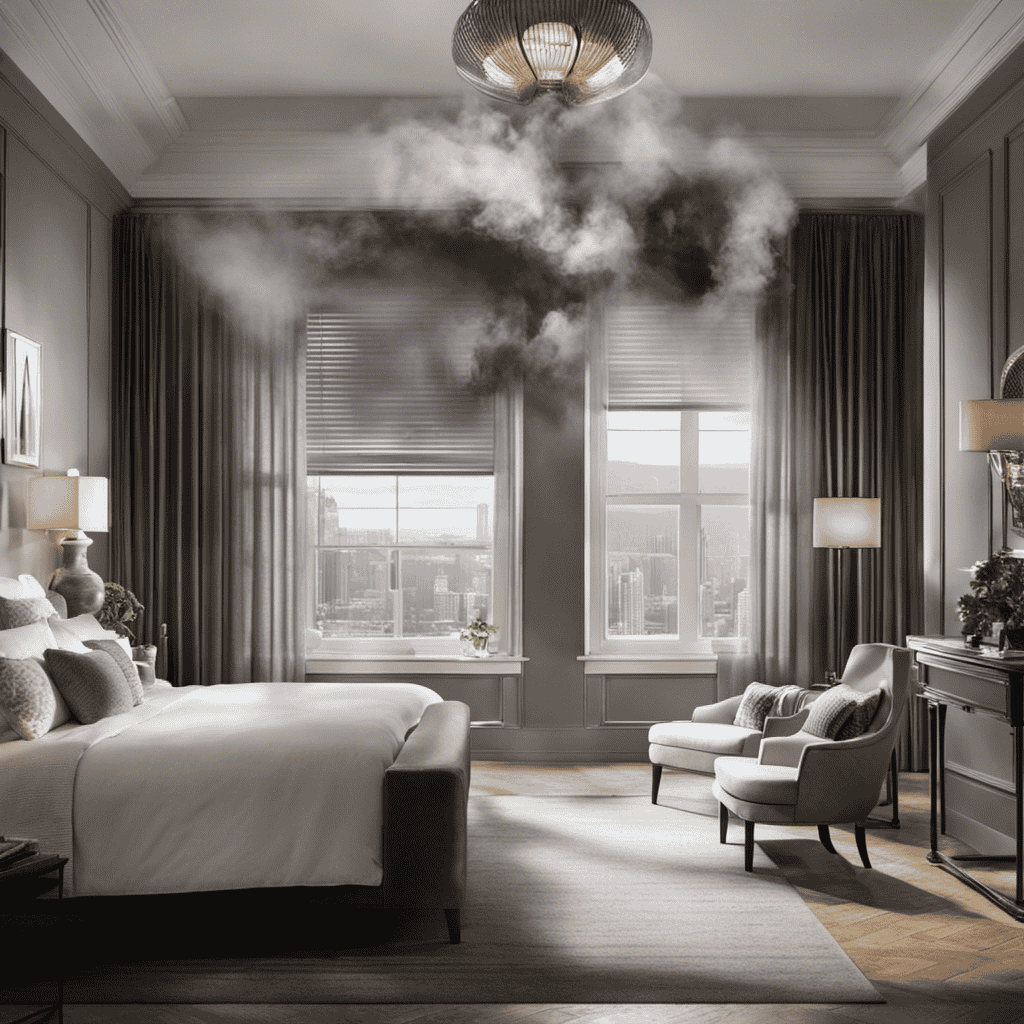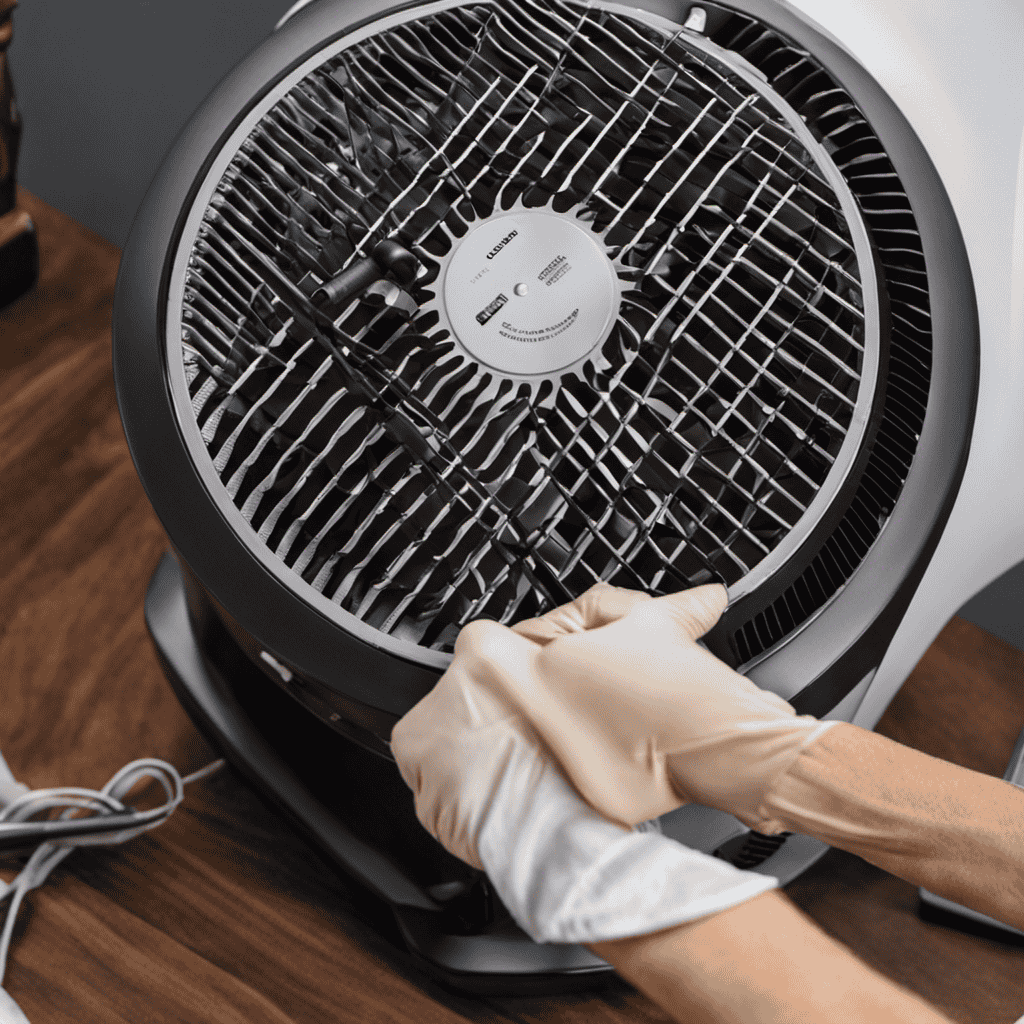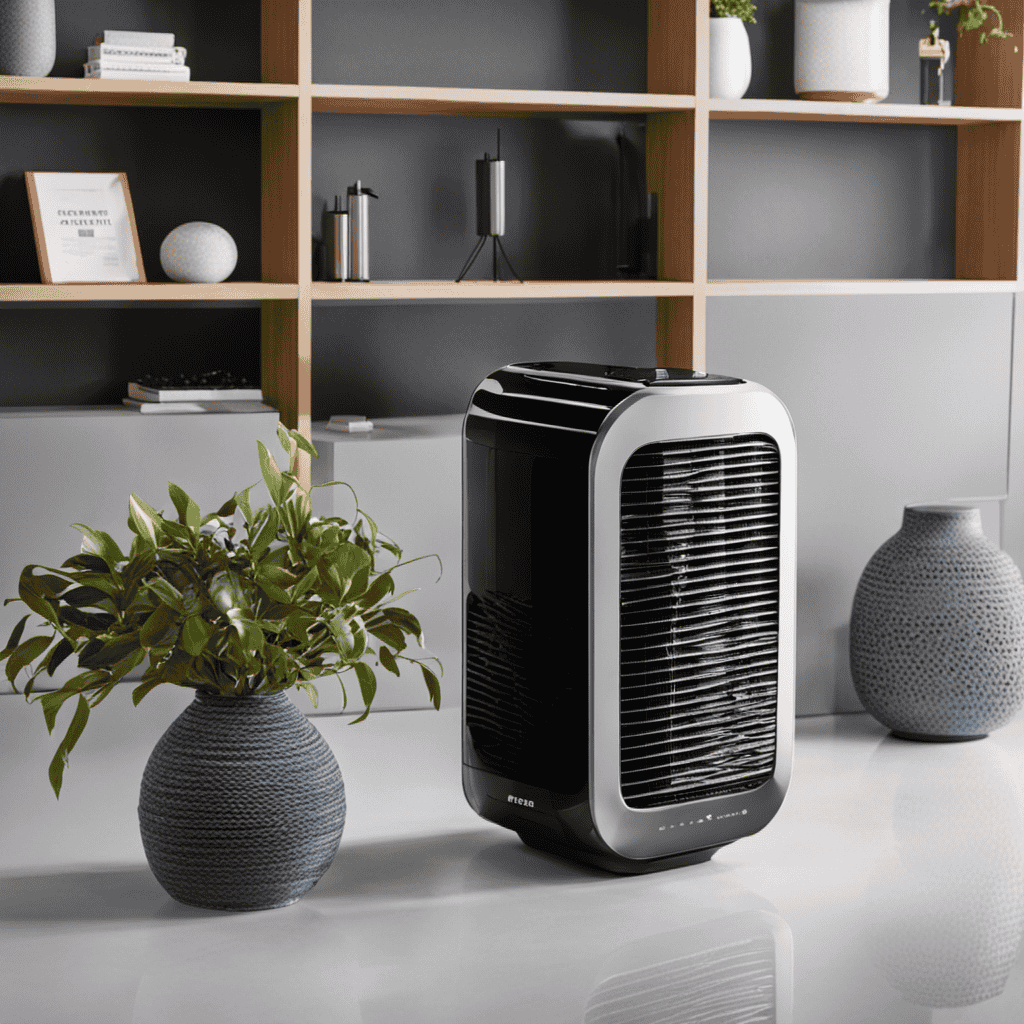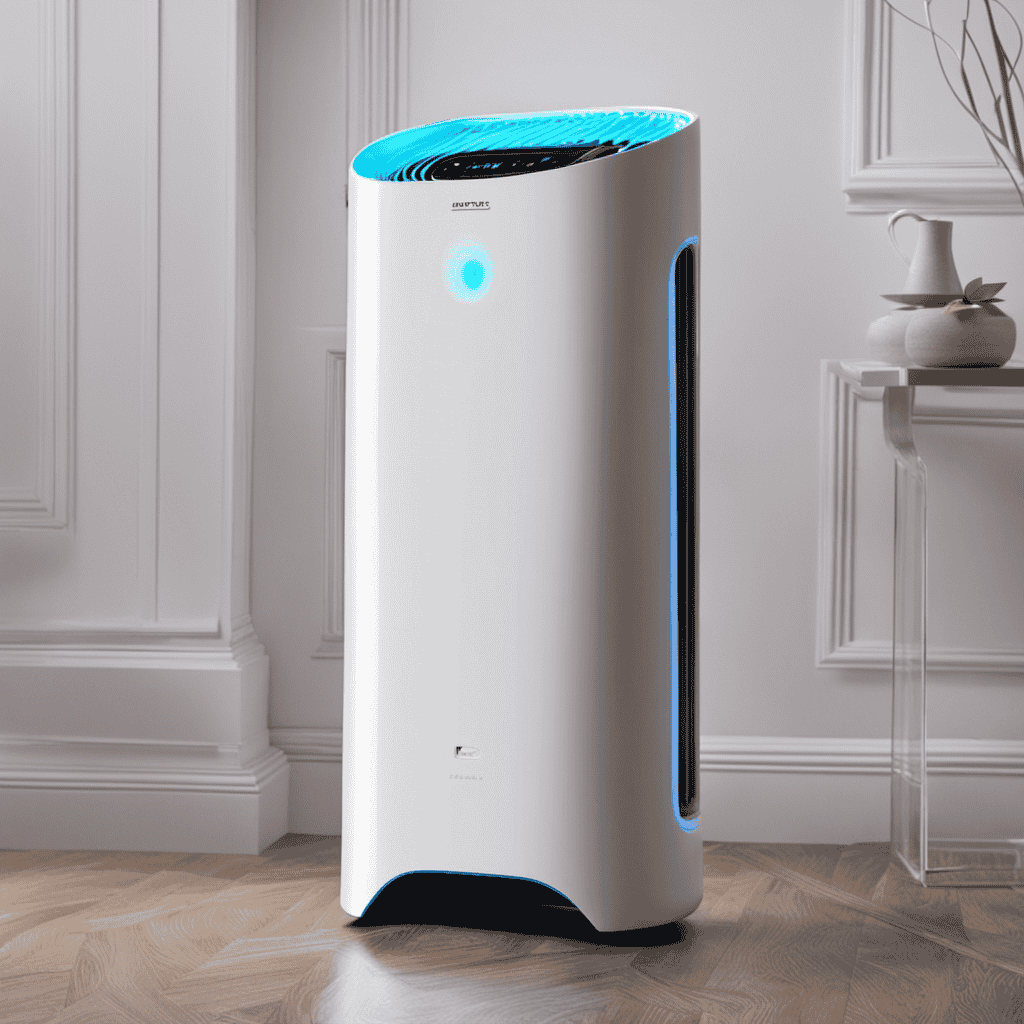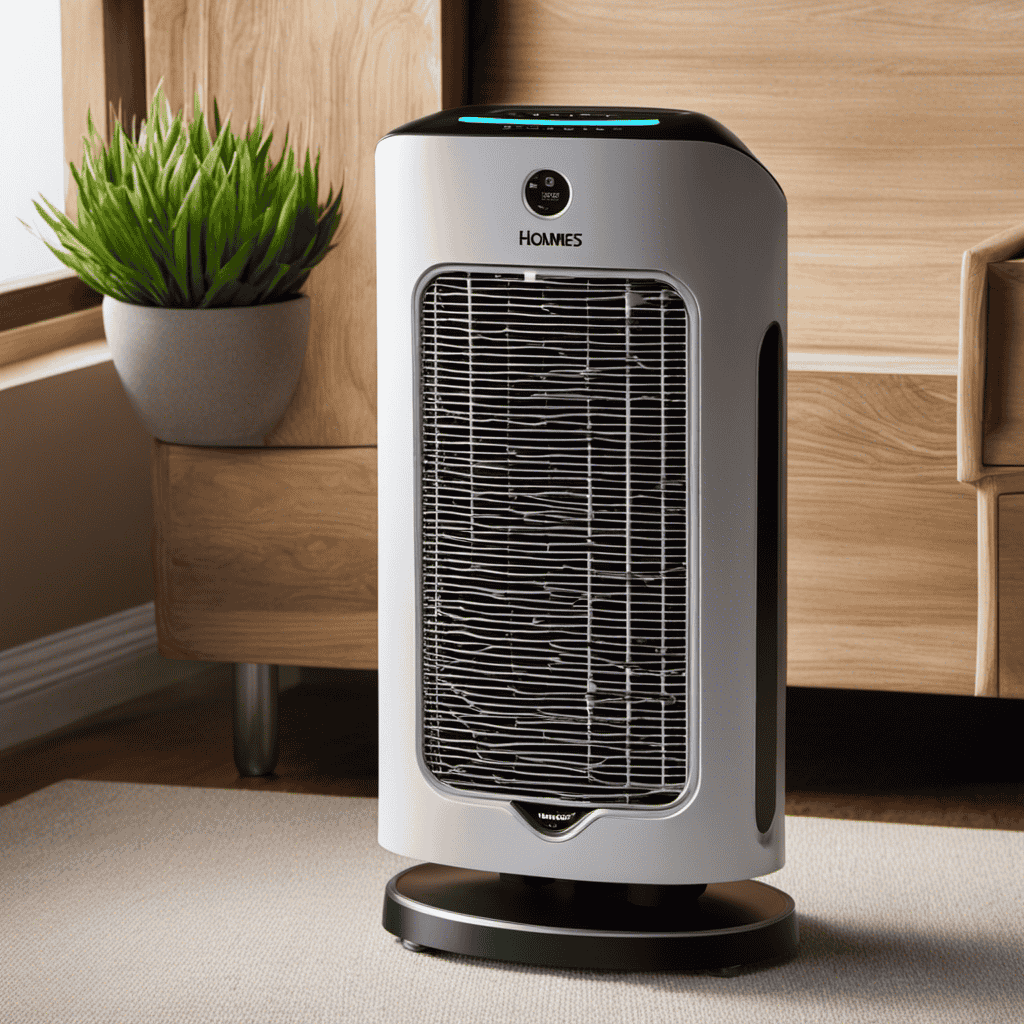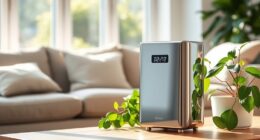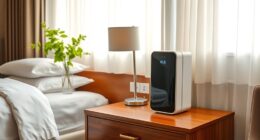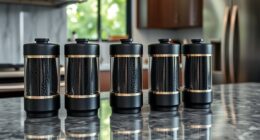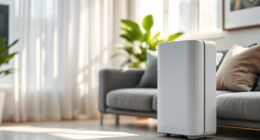Hello! If you’re similar to me and appreciate having an occasional indoor smoke, you understand the significance of maintaining clean and fresh air.
That’s where an air purifier comes in handy. With its powerful filtration system, it can help eliminate tobacco smoke particles and unpleasant odors, ensuring a healthier environment for you and your loved ones.
In this article, I’ll share some valuable insights on choosing the right air purifier for smoking, maintaining it properly, and maximizing its effectiveness.
So let’s dive in and clear the air!
Key Takeaways
- HEPA filters are highly effective in removing smoke particles from the air.
- Activated carbon filters help eliminate the unpleasant smell and improve indoor air quality.
- HEPA filters play a crucial role in creating a cleaner and healthier indoor environment for smokers and non-smokers alike.
- Regular maintenance, such as vacuuming the pre-filter and cleaning the HEPA filter, ensures the air purifier continues to provide clean, smoke-free air.
Types of Air Purifiers for Indoor Tobacco Smoke
There are different types of air purifiers that can be used to filter out tobacco smoke indoors. Indoor air pollution caused by secondhand smoke can have detrimental effects on our health.
As a knowledgeable consumer, it is important to consider the various options available when choosing an air purifier. HEPA (High-Efficiency Particulate Air) filters are highly effective in removing smoke particles from the air. They can capture even the smallest particles, including those found in tobacco smoke.
Another option is activated carbon filters, which can help remove the odor and chemicals present in tobacco smoke. Some air purifiers also incorporate ionizers, which release negative ions to attract and neutralize smoke particles.
Considering these different types of air purifiers can help create a smoke-free environment and improve indoor air quality.
Key Features to Look for in an Air Purifier for Smoking
One important feature to consider when looking for an air purifier for smoking is its ability to effectively remove odors. Here are three key features to look for in an air purifier for smoking:
-
Activated carbon filter: This type of filter is designed to absorb and trap odors, chemicals, and volatile organic compounds (VOCs) commonly found in tobacco smoke. It helps eliminate the unpleasant smell and improves indoor air quality.
-
High CADR rating: Clean Air Delivery Rate (CADR) measures how efficiently an air purifier can remove pollutants from the air. Look for a purifier with a high CADR rating to ensure it can effectively capture and filter out smoke particles.
-
HEPA filtration: HEPA filters are highly efficient at capturing tiny particles, including smoke particles. They can remove up to 99.97% of airborne pollutants as small as 0.3 microns in size, making them crucial for effective tobacco smoke purification.
Using an air purifier for smoking has numerous benefits, including reducing the smell of smoke, removing harmful particles from the air, and improving overall indoor air quality.
Now let’s explore the importance of HEPA filters in tobacco smoke purification.
The Importance of HEPA Filters in Tobacco Smoke Purification
When it comes to purifying smoke, one key feature to look for in an air purifier is the presence of a HEPA filter.
HEPA filters are known for their ability to effectively capture and remove small particles, including those found in tobacco smoke.
With their high efficiency in removing smoke particles, HEPA filters play a crucial role in creating a cleaner and healthier indoor environment for smokers and non-smokers alike.
HEPA for Smoke Purification
Using a HEPA air purifier is an effective way to purify smoke from tobacco inside. With its advanced filtration system, it can effectively remove harmful particles and eliminate smoke odors, ensuring a cleaner and healthier indoor environment.
Here are three reasons why a HEPA air purifier is an excellent choice for smoke purification:
-
High Efficiency: HEPA filters have a high capture rate for small particles, including smoke particles and volatile organic compounds (VOCs). They can trap up to 99.97% of particles as small as 0.3 microns, significantly reducing the presence of smoke in the air.
-
Activated Carbon Filters: Many HEPA air purifiers also come with activated carbon filters. These filters excel at absorbing and neutralizing smoke odors, leaving behind fresh and clean air.
-
Continuous Filtration: A HEPA air purifier operates continuously, ensuring that the air remains clean and free from smoke particles. It works silently in the background, providing round-the-clock smoke purification.
Investing in a HEPA air purifier is a holistic approach to effectively eliminate smoke odors and improve the air quality in your indoor space.
Tobacco Smoke Filtration
To effectively filter tobacco smoke, you’ll want to consider a HEPA air purifier with activated carbon filters. HEPA filters are known for their high efficiency in capturing airborne particles, including smoke particles. They can remove up to 99.97% of particles as small as 0.3 microns.
However, when it comes to tobacco smoke, additional filtration techniques are necessary.
Activated carbon filters are crucial in reducing secondhand smoke. They have a porous structure that absorbs odors and chemicals, effectively removing the harmful components of tobacco smoke. These filters can trap volatile organic compounds (VOCs) and other toxic substances, ensuring cleaner air quality.
Incorporating both HEPA and activated carbon filters in an air purifier creates a holistic approach to tobacco smoke filtration. It not only captures the visible smoke particles but also eliminates the invisible pollutants, making the air safer to breathe for both smokers and non-smokers.
How to Properly Maintain an Air Purifier for Smoking
Make sure you’re regularly cleaning the filters of your air purifier for smoking to ensure its effectiveness. Here are some key cleaning techniques to maximize efficiency:
-
Vacuum the pre-filter: Dust and debris can accumulate on the pre-filter, reducing its ability to capture smoke particles. Regularly vacuuming the pre-filter will help maintain its efficiency.
-
Wash or replace the carbon filter: The carbon filter is responsible for trapping odors from tobacco smoke. Depending on the manufacturer’s instructions, you may need to wash or replace it periodically to ensure optimal performance.
-
Clean the HEPA filter: The HEPA filter is designed to capture fine particles, including tobacco smoke. Clean it according to the manufacturer’s instructions to prevent clogging and maintain its effectiveness.
By following these cleaning techniques, you can keep your air purifier for smoking in top condition and ensure it continues to provide clean, smoke-free air.
Now, let’s explore the best air purifiers for large rooms or open spaces.
Best Air Purifiers for Large Rooms or Open Spaces
If you have a large room or open space, you’ll want to consider the best air purifiers to effectively clean the air. When it comes to air purifiers for large rooms, there are a few key features to look for.
First and foremost, you want a purifier that has a high CADR (Clean Air Delivery Rate), which indicates how quickly it can remove pollutants from the air. Additionally, consider a purifier with a large coverage area and multiple filtration stages to ensure thorough purification.
Some top-rated air purifiers for large spaces include the Dyson Pure Cool Tower and the Coway Airmega 400. These models have been praised for their powerful performance and ability to eliminate smoke odors.
By investing in a high-quality air purifier and following proper maintenance guidelines, you can greatly improve the air quality in your space and eliminate smoke odors.
Now, let’s explore some tips for maximizing the effectiveness of an air purifier for smoking.
Tips for Maximizing the Effectiveness of an Air Purifier for Smoking
When it comes to maximizing the effectiveness of an air purifier for smoking, there are three key points to consider: filter replacement frequency, proper placement, and positioning.
Regularly replacing the filters is crucial to ensure that the air purifier continues to effectively remove smoke particles from the air.
Additionally, placing the purifier in the right location, such as near the source of smoke or in the center of the room, can greatly enhance its ability to capture and filter out tobacco smoke.
Filter Replacement Frequency
To ensure clean air while smoking tobacco inside, you’ll need to regularly replace the filters in your air purifier. The lifespan of the filters depends on various factors, including the quality of the filters and the frequency of smoking.
Here are three key points to consider regarding filter replacement frequency:
-
Filter Lifespan: High-quality filters typically last longer, ranging from 3 to 6 months. However, if you smoke heavily or in a confined space, the filters may need to be replaced more frequently.
-
Smoking Frequency: The more often you smoke, the more quickly your filters will become saturated with smoke particles and odors. Regular smokers may need to replace their filters every 2-3 months.
-
Cost of Filter Replacements: It’s important to factor in the cost of filter replacements when purchasing an air purifier. Some filters can be expensive, so be sure to consider this when budgeting for your smoking habit.
Proper Placement and Positioning
Properly positioning your air purifier can optimize its performance and ensure effective air cleaning. When it comes to maintaining clean air in your home, placement is key.
To maximize the benefits of your air purifier, it is important to consider the recommended room size and strategically place it in an area where it can circulate air efficiently. Ideally, the purifier should be placed in a central location within the room, away from walls or furniture that may obstruct airflow.
Additionally, avoid placing it near heat sources or in direct sunlight, as this can affect its performance. Regular maintenance is also crucial for optimal functioning. Follow the manufacturer’s instructions for filter replacement and cleaning to ensure that your air purifier continues to work effectively and efficiently.
Frequently Asked Questions
Can Air Purifiers Completely Eliminate the Smell of Tobacco Smoke?
Yes, air purifiers can effectively eliminate the smell of tobacco smoke. The best air purifiers for smokers have HEPA filters and activated carbon filters, which can capture and remove smoke particles and odors.
What Is the Average Lifespan of an Air Purifier for Smoking?
The average lifespan of an air purifier for smoking depends on maintenance requirements. Regularly cleaning and replacing filters can extend its life. However, tobacco smoke can be stubborn, so don’t expect miracles.
Do Air Purifiers for Smoking Require Any Additional Accessories or Filters?
There are air purifiers for smoking that may require additional accessories like carbon filters. Some models offer different filter options, such as HEPA or activated carbon filters, to effectively remove tobacco smoke particles from the air.
Can Air Purifiers Remove the Harmful Chemicals Found in Tobacco Smoke?
Air purifiers can effectively remove the harmful chemicals found in tobacco smoke, providing numerous benefits. The use of air purifiers helps to improve indoor air quality and reduces the health risks associated with secondhand smoke.
Are There Any Potential Health Risks Associated With Long-Term Use of Air Purifiers for Smoking?
Using air purifiers for smoking indoors may have potential health risks with long-term use. However, they are effective in removing tobacco smoke odor. It’s important to consider other factors and practice good ventilation for a holistic approach to indoor air quality.
Conclusion
In conclusion, choosing the right air purifier for smoking tobacco inside is crucial for maintaining a clean and healthy indoor environment. With the right features, such as a HEPA filter, these purifiers can effectively remove harmful particles and odors associated with smoking.
Remember to properly maintain your air purifier to ensure its optimal performance.
Additionally, it’s interesting to note that according to a study conducted by the American Lung Association, indoor air pollution can be up to five times worse than outdoor air pollution, making the use of air purifiers even more important in creating a smoke-free environment.
